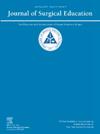倾斜天平:量化USMLE第1步合格/不合格评分对综合整形手术匹配应用解释的影响
IF 2.1
3区 医学
Q1 EDUCATION, SCIENTIFIC DISCIPLINES
引用次数: 0
摘要
目的美国医师执照考试®(USMLE®)第1步考试实施通过/不通过评分,以“创建一个更全面的住院医师申请选择过程”。我们的目的是评估这种转变是有利于整体评价还是将重点转向其他指标。设计从提交给单一学术中心的330份整形外科常见申请(psca)中收集可量化的数据。申请人根据数字或通过/不通过第1步的分数分为两组。对每组进行逻辑回归,以评估基于可量化应用程序组件的匹配几率。设置2023-2024匹配周期。参与者330名综合整形申请者。结果共有137个申请报告了数字步骤1分数,而193个报告了通过/不通过分数。对于具有数字第1步分数的申请人,最能预测匹配的因素是第2步得分>;265 (OR 159 [95% CI, 6.6-999]),第1步得分在240和250之间(OR 21.8 [95% CI, 4.8-98.6]),以及美国公民(OR 21.1 [95% CI, 3.9-116])。推荐信的数字强度(OR 11.0 [95% CI, 2.7-45.6])也是显著的匹配预测因子,其次是超过16次的讲台演讲(OR 10.8 [95% CI, 2.6-45.5])。相比之下,对于第1步成绩及格/不及格的学生,只有3个显著因素预测匹配成功:推荐信的强度(OR 3.7 [95% CI, 1.8-7.6]), Alpha Omega Alpha协会会员资格(OR 3.2 [95% CI, 1.3-7.7]),以及毕业于《美国新闻与世界报道》排名前40位的医学院(OR 3.0 [95% CI, 1.5-6.1])。结论对于具有数字1步分数的申请人,1步和2步分数仍然是最关键的匹配因素。相比之下,推荐信的强度和从排名前40位的医学院毕业对于通过/不通过评分的申请人来说是最重要的,这表明在评分变化后,申请人转向了其他申请指标。本文章由计算机程序翻译,如有差异,请以英文原文为准。
Tipping the Scales: Quantifying the Impact of USMLE Step 1 Pass/Fail Scoring on Application Interpretation in the Integrated Plastic Surgery Match
Objective
The United States Medical Licensing Exam® (USMLE®) Step 1 exam implemented pass/fail scoring to "create a more holistic residency application selection process.” We aimed to assess whether this transition favored holistic review or redirected emphasis to other metrics.
Design
Quantifiable data from 330 Plastic Surgery Common Applications (PSCAs) submitted to a single academic center were collected. Applicants were stratified into 2 groups based on numeric or pass/fail Step 1 score. Logistic regression was performed for each group to assess the odds of matching based on quantifiable application components.
Setting
2023-2024 Match cycle.
Participants
330 integrated plastic surgery applicants.
Results
A total of 137 applications reported numeric Step 1 scores, while 193 reported pass/fail scores. For applicants with a numeric Step 1 score, the factors most predictive of matching were Step 2 score >265 (OR 159 [95% CI, 6.6-999], Step 1 Score between 240 and 250 (OR 21.8 [95% CI, 4.8-98.6]), and being a U.S. citizen (OR 21.1 [95% CI, 3.9-116]). Letter of recommendation numeric strength (OR 11.0 [95% CI, 2.7-45.6]) was also a significant match predictor, followed by more than 16 podium presentations (OR 10.8 [95% CI, 2.6-45.5]). In comparison, for students with pass/fail Step 1 scores, there were only 3 significant factors that predicted a successful match: strength of recommendation letters (OR 3.7 [95% CI, 1.8-7.6]), Alpha Omega Alpha society membership (OR 3.2 [95% CI, 1.3-7.7]), and graduation from a U.S News and World Report top 40 medical school in research (OR 3.0 [95% CI, 1.5-6.1]).
Conclusion
For applicants with a numeric Step 1 score, Step 1 and 2 scores remained the most critical match factors. In comparison, letter of recommendation strength and graduation from a top 40 medical school were most important for applicants with pass/fail scoring, indicating a shift toward other application metrics following the scoring change.
求助全文
通过发布文献求助,成功后即可免费获取论文全文。
去求助
来源期刊

Journal of Surgical Education
EDUCATION, SCIENTIFIC DISCIPLINES-SURGERY
CiteScore
5.60
自引率
10.30%
发文量
261
审稿时长
48 days
期刊介绍:
The Journal of Surgical Education (JSE) is dedicated to advancing the field of surgical education through original research. The journal publishes research articles in all surgical disciplines on topics relative to the education of surgical students, residents, and fellows, as well as practicing surgeons. Our readers look to JSE for timely, innovative research findings from the international surgical education community. As the official journal of the Association of Program Directors in Surgery (APDS), JSE publishes the proceedings of the annual APDS meeting held during Surgery Education Week.
 求助内容:
求助内容: 应助结果提醒方式:
应助结果提醒方式:


